The NVIDIA Titan V Preview - Titanomachy: War of the Titans
by Ryan Smith & Nate Oh on December 20, 2017 11:30 AM ESTPower, Temperature, & Noise
Finally, let's talk about power, temperature, and noise. At a high level, the Titan V should not be substantially different from other high-end NVIDIA cards. It has the same 250W TDP, and the cooler is nearly identical to NVIDIA’s other vapor chamber cooler designs. In short, NVIDIA has carved out a specific niche on power consumption that the Titan V should fall nicely into.
Unfortunately, no utilities seem to be reporting voltage or HBM temperature of Titan V at this time. These would be particularly of interest considering that Volta is fabbed on TSMC's bespoke 12FFN as opposed to 16nm FinFET. This also marks the first time NVIDIA has implemented HBM2 in gaming use-cases, where HBM temperatures or voltages could be elucidating.
| NVIDIA Titan V and Xp Average Clockspeeds | |||
| NVIDIA Titan V | NVIDIA Titan Xp | Percent Difference | |
| Idle | 135MHz | 139MHz | - |
| Boost Clocks |
1455MHz
|
1582MHz
|
-8.0% |
| Max Observed Boost |
1785MHz
|
1911MHz
|
-6.6% |
| LuxMark Max Boost | 1355MHz | 1911MHz | -29.0% |
| Battlefield 1 |
1651MHz
|
1767MHz
|
-6.6% |
| Ashes: Escalation |
1563MHz
|
1724MHz
|
-9.3% |
| DOOM |
1561MHz
|
1751MHz
|
-10.9% |
| Ghost Recon |
1699MHz
|
1808MHz
|
-6.0% |
| Deus Ex (DX11) |
1576MHz
|
1785MHz
|
-11.7% |
| GTA V |
1674MHz
|
1805MHz
|
-7.3% |
| Total War (DX11) | 1621MHz | 1759MHz | -7.8% |
| FurMark |
1200MHz
|
1404MHz
|
-14.5% |
Interestingly, LuxMark only brings Titan V to 1355MHz instead of its maximum boost clock, a behavior that differs from every other card we've benched in recent memory. Other compute and gaming tasks do bring the clocks higher, with a reported peak of 1785MHz.
The other takeaway is that Titan V is consistently outclocked by Titan Xp. In terms of gaming, Volta's performance gains do not seem to be coming from clockspeed improvements, unlike the bulk of Pascal's performance improvement over Maxwell.
Meanwhile it's worth noting that the HBM2 memory on the Titan V has only one observed clock state: 850MHz. This never deviates, even during FurMark as well as extended compute or gameplay. For the other consumer/prosumer graphics cards with HBM2, AMD's Vega cards downclock HBM2 in high temperature situations like FurMark, and also features a low-power 167MHz idle state.
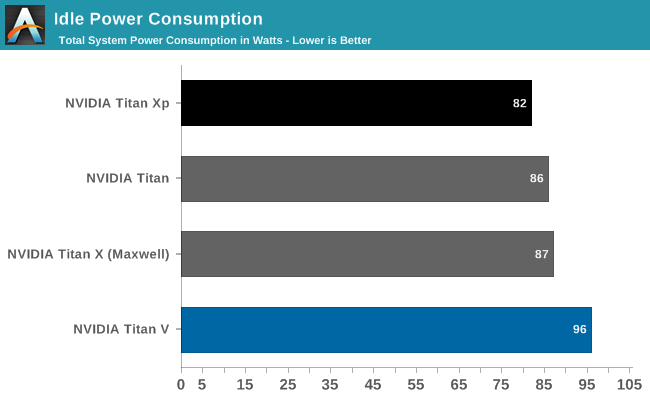
Measuring power from the wall, Titan V's high idle and lower load readings jump out.
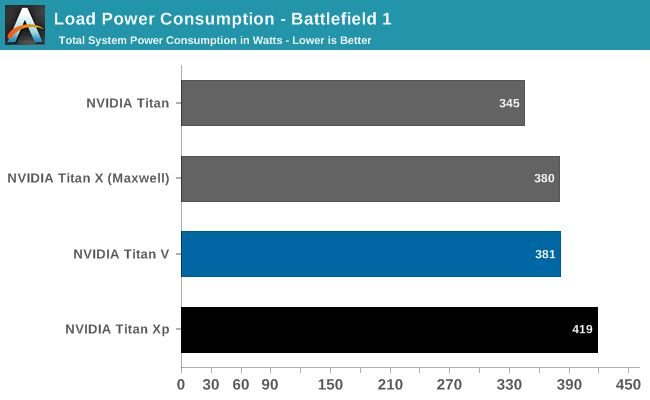
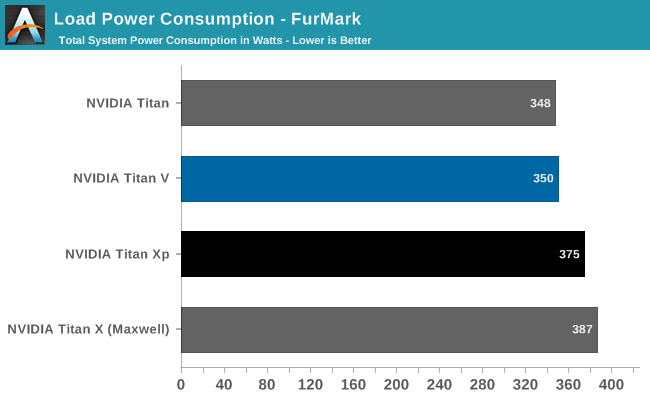
Meanwhile under load, the Titan V's power consumption at the wall is slightly but consistently lower than the Titan Xp's. Again despite the fact that both cards have the same TDPs, and NVIDIA's figures tend to be pretty consistent here since Maxwell implemented better power management.

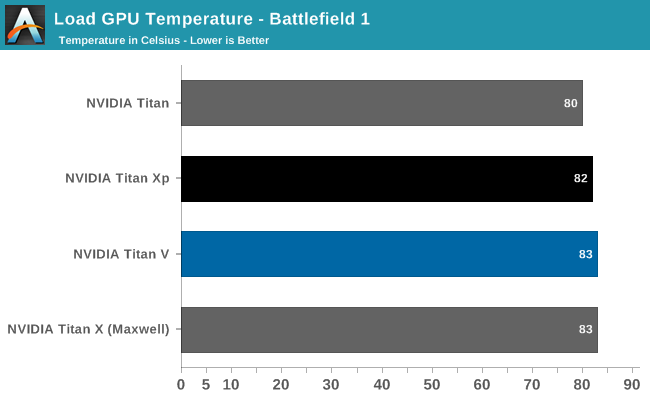
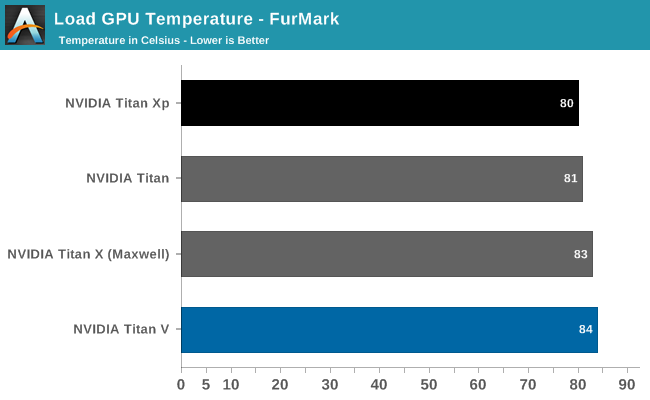
During the course of benchmarking, GPU-Z reported a significant amount of Titan V thermal throttling, and that continued in Battlefield 1, where it oscillated between being capped out by GPU underutilization and temperature. And in FurMark, the Titan V was consistently temperature-limited.
Without HBM2 voltages, it is hard to say if the constant 850MHz clocks are related to Titan V's higher idle system draw. 815mm2 is quite large, but then again elements like Volta's tensor cores are not being utilized in gaming. In Battlefield 1, system power draw is actually lower than Titan Xp but GPU Z would suggest that thermal limits are the cause. Typically what we've seen with other NVIDIA 250W TDP cards is that they hit their TDP limits more often than they hit their temperature limits. So this is an unusual development.
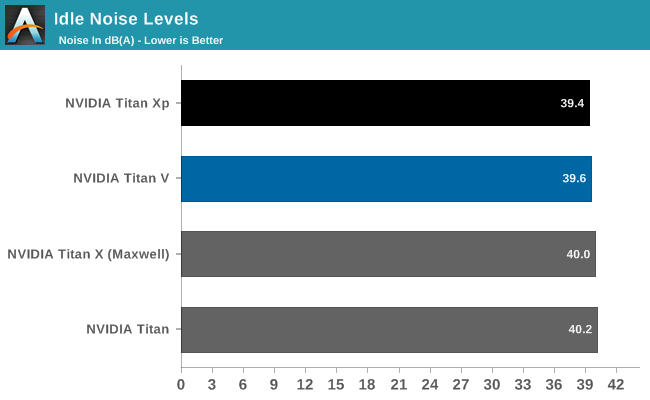
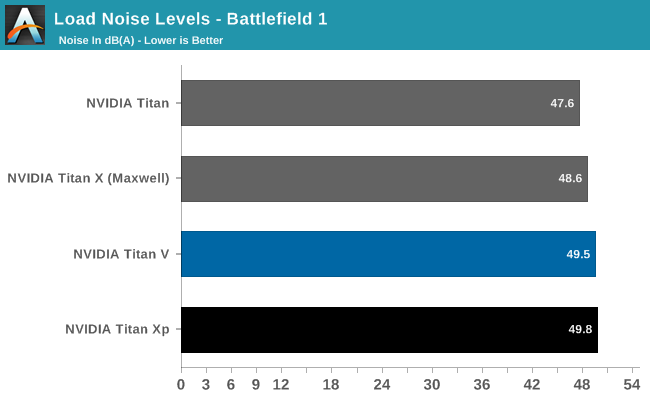
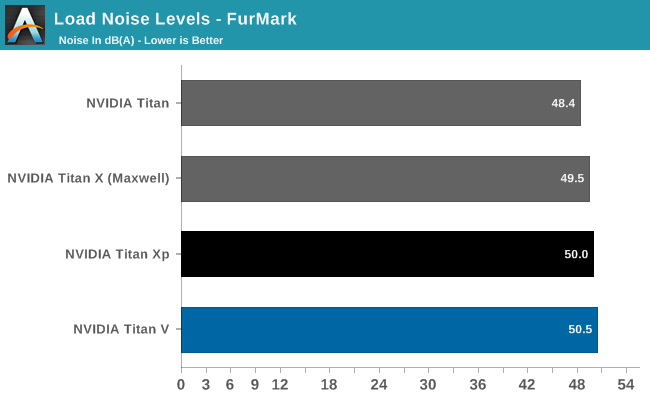
Featuring an improved cooler, Titan V essentially manages the same noise metrics as its Titan siblings.










111 Comments
View All Comments
CiccioB - Thursday, December 21, 2017 - link
Absolute boost frequency is meaningless as we have already seen that those values are not respected anywhere with the use of boost 3.0. You can be higher or lower.What is important is the power draw and the temperatures. These are the limiting factors to reach and sustain the boost frequency and beyond.
With a 800+mm^2 die and 21 billions of transistor you may expect that the consumption is not that low as for a 14 billion die, and the frequencies cannot be sustained that much.
What is promising is that if these are the power drain of such a monster chip, the consumer grade chips made on the same PP will really be fresh and that the frequencies can be pushed really high to suck all the thermal and power drain gap.
Just imagine a Volta/Ampere GP104 consuming 300+W, same as the new Vega GPU based custom cards.
#poorVega
croc - Wednesday, December 20, 2017 - link
I can't take a titan-as-compute seriously if its double precision is disabled That, to me, makes it only aimed at graphics Yet this whole article is expressing the whole titan family as 'compute machines'...MrSpadge - Thursday, December 21, 2017 - link
It has all compute capability enabled: FP16, FP32, FP64 and the tensor cores. The double speed FP16 is just not (yet?) exposed to graphics applications.CiccioB - Thursday, December 21, 2017 - link
In fact this one has 1/2 FP64 computing capacity with respect to FP32.At least read the first chapter of the review before commenting.
mode_13h - Wednesday, December 27, 2017 - link
The original Titan/Black/Z and this Titan V have uncrippled fp64. It's only the middle two generations - Titan X and Titan Xp - that use consumer GPUs with a fraction of the fp64 units.Zoolook13 - Thursday, December 21, 2017 - link
The figure for tensor operations seems fishy, it's not based on tf.complex128 I guess more probably tf.uint8 or tf.int8 and then it's no longer FLOPS, maybe TOPS?I hope you take a look at that when you flesh out the tensorflow part.
If they can do 110 TFLOPS of tf.float16, then it's very impressive but I doubt that.
Ryan Smith - Thursday, December 21, 2017 - link
It's float 16. Specifically, CUDA_R_16F.http://docs.nvidia.com/cuda/cublas/index.html#cubl...
CheapSushi - Thursday, December 21, 2017 - link
Would be amazing if tensor core support was incorporated into game AI and also OS AI assistants, like Cortana.edzieba - Thursday, December 21, 2017 - link
"Each SM is, in turn, contains 64 FP32 CUDA cores, 64 INT32 CUDA cores, 32 FP64 CUDA cores, 8 tensor cores, and a significant quantity of cache at various levels."IIRC, the '64 FP32 cores' and '32 FP64 cores' are one and the same: the FP64 cores can operate as a pair of FP32 cores (same as GP100 can do two FP16 operations with the FP32 cores).
Ryan Smith - Thursday, December 21, 2017 - link
According to NVIDIA, the FP64 CUDA cores are distinct silicon. They are not the FP32 cores.